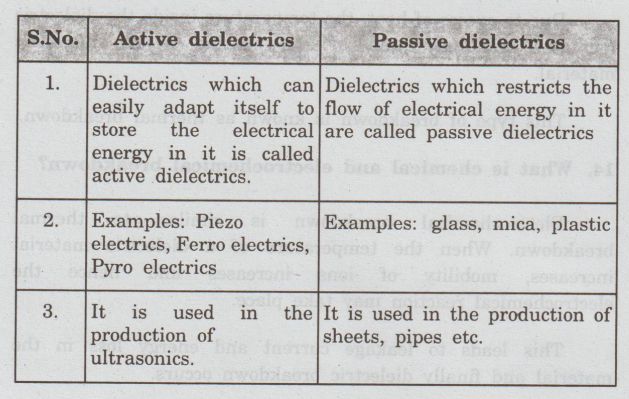Physics for Electrical Engineering: Unit I: Dielectric Materials and Insulation
Part A - 2 Marks Questions and Answer
Dielectric Materials and Insulation | Physics for Electrical Engineering
Physics for Electrical Engineering: Unit I: Dielectric Materials and Insulation : Part - A '2' Marks Q And A - Anna university q and a
Part - A '2' Marks Q
& A
ANNA UNIVERSITY
Q&A
1. Define dielectric constant. (A.U.
Jan 2014)
It is the ratio between absolute permittivity
of the medium (ε) and permittivity of free space (ε0)
Dielectric
constant εr = Absolute
permittivity (ε) / permittivity of free space (ε0)
εr=
ε / ε0
2. Define polarisation of a
dielectric material. (A.U. June 2015)
The
process of producing electrical dipoles inside the dielectric by the
application of an external electrical field is called polarisation in
dielectrics.
Induced
dipole moment (μ) = α E
E
→ Applied electrical field
α
→ Polarizability
3. Name the four polarisation
mechanisms. ( A. U. May 2016 )
(i)
Electronic polarisation
(ii)
Ionic polarisation
(iii)
Orientational polarisation
(iv)
Space charge polarisation.
4. What is electronic polarisation?
(A.U. May 2016)
The
induced dipole moment produced in an atom by the application of electrical
field is known as electronic polarization. It is due to shifting of negatively
charged electron and positively charged nucleus charges of atom in the material
by the applied electric field.
5. What is ionic polarisation? (A.U.
May 2014)
Ionic
polarisation is due to the displacement of cations (negative ions) and anions
(positive ions) in opposite direction due to the application of an electrical
field. This occurs in an ionic solid.
6. What is orientational
polarisation? (A.U. May 2012)
When
an electrical field is applied on the dielectric medium with polar molecules,
the dipoles align themselves in the field direction and thereby increases
electric dipole moment.
Such
a type of contribution to polarisation due to the orientation of permanent
dipoles by the applied field is called orientational polarisation.
7. What is space - charge
polarisation? (A.U. May 2013)
In
some materials containing two or more phases, the application of an electrical
field causes the accumulation of charges at the interfaces between the phases or
at the electrodes.
As
a result of this, polarisation is produced. This type of polarisation is known
as space charge polarisation.
8. What is meant by local field in
a dielectric? (A.U. Jan 2012)
When
a dielectric is kept in an external electric field (E), two fields are exerted
due to (i) external field and (ii) dipole moment created
These
long range coulomb forces which are created due to the dipoles are called local
field in dielectric
It
is given by Eint =E + p / 3 ε0
where
P→ polarisation
ε0
→ permitivity in free space.
9. Define dielectric loss and loss
tangent. (A.U. Jan 2012, June 2013)
When
a dielectric material is subjected to an A.C voltage, the electrical energy is
absorbed by the material and is dissipated in the form of heat. This dissipation
of energy is called dielectric loss.
In
a perfect insulator, polarisation is complete during each cycle and there is no
consumption of energy and the charging current leads the applied voltage by
90°.
But
for commercial dielectric, this phase angle is less than 90° by an angle δ and
is called dielectric loss angle. Tan 8 is taken as a measure of dielectric loss
and is known as loss tangent.
10. Define dielectric breakdown and
dielectric strength. (A.U. Jan 2013)
Whenever
the electrical field strength applied to a dielectric exceeds a critical value,
very large current flows through it. The dielectric loses its insulating
property and becomes conducting. This phenomenon is known as dielectric
breakdown.
The
electrical field strength at which dielectric breakdown occurs is known as
dielectric strength.
11. Mention the various breakdown
mechanisms. (A.U. Dec. 2012)
(i
)Intrinsic breakdown and avalanche breakdown
(ii)The
Thermal breakdown
(iii)
Chemical and Electrochemical breakdown
(iv)
Discharge breakdown
(v)
Defect breakdown
12. What is intrinsic breakdown?
For
a dielectric, the charge displacement increases with increasing electrical
field strength. Beyond a critical value of electrical field strength, there is
an electrical breakdown due to physical deterioration in the dielectric
material.
13. What is thermal breakdown?
When
an electrical field is applied to a dielectric material, some amount of heat is
produced. This heat must be dissipated from the material.
Due
to excess of heat, the temperature inside the dielectric increases and may
produce local melting in the dielectric material.
This
type of breakdown is known as thermal breakdown.
14. What is chemical and
electrochemical breakdown?
Electrochemical
breakdown is similar to thermal breakdown. When the temperature of a dielectric material
increases, mobility of ions increases and hence the electrochemical reaction
may take place.
This
leads to leakage current and energy loss in the material and finally dielectric
breakdown occurs.
15. What is discharge breakdown?
ortay
Discharge
breakdown occurs when a dielectric contains occluded gas bubbles. When this
type of dielectric is subjected to electrical field, the gases present in the
material will easily ionise and thus produce large ionisation current.
The
gaseous ions bombard the solid dielectric. This causes electrical deterioration
and leads to dielectric breakdown.
16. What is defect breakdown?
The
surface of the dielectric material may have defects such as cracks, porosity
and blow holes. Impurities like dust or moisture may collect at these
discontinuities (defects). This will lead to a breakdown in a dielectric
material.
17. Mention any two active and
passive dielectrics with their applications (or) Compare active and passive
dielectrics. (A.U. April 2013)

Physics for Electrical Engineering: Unit I: Dielectric Materials and Insulation : Tag: : Dielectric Materials and Insulation | Physics for Electrical Engineering - Part A - 2 Marks Questions and Answer
Related Topics
Related Subjects
Physics for Electrical Engineering
PH3202 2nd Semester 2021 Regulation | 2nd Semester EEE Dept 2021 Regulation
